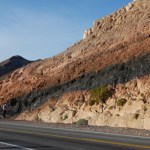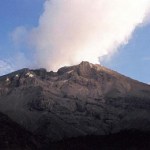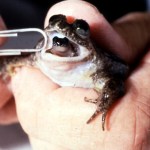Extinction
By Noel Feans (originally posted to Flickr as Watch your back!) [CC BY 2.0 (http://creativecommons.org/licenses/by/2.0)], via Wikimedia Commons
New research suggests that cats may have played a role in the extinction of about 40 species of wild dogs by simply out-hunting them and therefore consuming more food.
The study noted that dogs first appeared in North America around 40 million years ago and by 22 million years ago there were over 30 species of wild dogs. Cats arrived from Asia around 20 million years after dogs appeared. The arrival of cats…
On Greg Laden's Blog, we learn that "a subspecies of 'Black Rhino' also known as the 'browsing rhino'" has gone extinct in Africa, while Northern White Rhinos and Javan Rhinos have likely met the same fate. Dr. Dolittle says the last known Javan rhinoceros in Vietnam was found "with its horn cut off, most likely a victim of poachers. Another subspecies, The Indian Javan rhino (R. sondaicus inermis), is believed to have gone extinct in the early 20th century." Fifty individuals still linger in West Java, and thousands of White Rhinos still roam in Africa, but on the whole this family is…
Okay, so this one is a bit of a tear-jerker and I usually like to avoid mixing sentimentality with environmentalism, but it is very informative and interesting if sad. It is greenman3610's Climate Crock of the Week from about three weeks ago and as usual well worth watching.
I tend to be skeptical about anthropomorphizing our fellow earthlings, but I'll be damned if that wasn't a very affectionate mama walrus hugging her baby! If walruses weren't so ugly they just might top polar bears in terms of public concern...
The Triassic is old. This book is new. That is a hard to beat combination.
Let's see ... The Triassic is about here:
(You can also look it up in this PDF file supplied by the USGS.
It is situated between two major extinction events, and is especially interesting because it is during this period that modern day ecological systems and major animal groups took a recognizable form. The preceding Permian, if contrasted with modern day, would form a very stark contrast while the Triassic would be at least somewhat more recognizable.
But of course the Triassic was in many ways distinct,…
The skeleton of the Hundsheim rhinoceros, Stephanorhinus hundsheimensis. From Kahlke and Kaiser, 2010.
In any given environment, it might be expected that a generalized or unspecialized species might be less prone to extinction than one which depends upon a narrow temperature range, a peculiar kind of food, or other aspect of natural history which is key to its survival. An herbivorous mammal which can subsist on a variety of grasses, leaves, and other plant foods, for example, may be more likely to survive an ecological disruption than a species tied to foliage which might die back during…
The nearly complete skeleton of a Steller's sea cow (Hydrodamalis gigas) - it is missing bones from the wrist and hand. From Woodward, 1885.
It did not take long for the last remaining population of Steller's sea cow to be driven into extinction. Discovered by the German naturalist Georg Steller around the Bering Sea's Commander Islands in 1741, this enormous and peculiar sirenian became an easy target for Russian hunters. By 1768, it was gone. (The marine mammal would not be scientifically described until 1780, and today it is formally known as Hydrodamalis gigas.) Yet, despite the clear…
Components of the newly-described Fezouata fauna. a, Demosponge Pirania auraeum b, Choiid demosponge c, Annelid worm d, Organism showing possible similarities to halkieriids e, Possible armoured lobopod f, Thelxiope-like arthropod g, Marrellomorph arthropod, probably belonging to the genus Furca h, Skaniid arthropod i, Spinose arthropod appendage
apparatus consisting of six overlapping elements. From Van Roy et al, 2010.
When the Cambrian period comes up in conversation, it is usually in reference to the evolutionary "explosion" which occurred around 530 million years ago. Animal fossils…
A large part of my affection for science comes from the thrill of terror I get when a particularly insane piece of science news hits the presses. When an article begins with a sentence like, "there is something strange in the cosmic neighborhood," or "all the black holes found so far in our universe may be doorways into alternate realities," my pulse quickens and a dormant paranoia is roused from deep within my breast: a sensation of joyful panic. I used to call this the "fourth-grade nightmare fantasy." This might be because as a long-time science fiction adept, I tend to read science news…
I'm still playing catch-up after my week in the desert, so I've seen a lot of articles I've wanted to mention ... but a certain other volcano has taken up a lot of my time. However, I will attempt to make amends for that now.
By the way, would you believe Ubehebe Crater was closed? How do they close a volcano, anyway? However, I did get a great snap of a welded tuff on the road outside of Shoshone, CA.
A strongly welded tuff near Shoshone, CA. The dark interior is remelted volcanic ash/tephra surrounded by less welded pink tuff with abundant pumice clasts. Denison student David Sisak is on…
A muskox (Ovibos moschatus), photographed in Alaska. From Flickr user drurydrama.
Of all the mass extinctions that have occurred during earth's history, among the most hotly debated is the one which wiped out mammoths, saber-toothed cats, giant ground sloths, and the other peculiar members of the Pleistocene megafauna around 12,000 years ago. It was not the most severe mass extinction, not by a long shot, but unlike the end-Cretaceous catastrophe 65 million years ago there is no single "smoking gun" that can account for the pattern of extinction. Instead the Pleistocene mass extinction…
Modern civilization has extremely deleterious consequences in regards to species richness, primarily through destruction of habitat. Because of these negative aspects of modernity hunter-gatherers have been idealized as a model of humanity at equilibrium with their ecology. 1491: New Revelations of the Americas Before Columbus lays out the revisionist, and to some extent now mainstream, argument that the American wilderness which European settlers encountered was actually an instance of "re-wilding" in the wake of native demographic collapse due to disease. But setting this case aside, what…
News to finish up your week:
Summit area of Hualalai in Hawai'i
Another day, another "threat" of volcanic eruption in Australia. I'm impressed with the abject fear Aussies seem to have for this perceived increased threat of an eruption - or at least what the press wants you to believe. This time, watch out near Bundaberg, Townsville and Cooktown in southeast Queensland!
In more press-related exaggeration, the Siberian Traps - a flood basalt eruption from, well, thousands of rift/vents in Siberia - is boiled down to being one Siberian volcano by the Telegraph. Dr. Mark Sephton of the…
As sufferers of post-traumatic stress syndrome know all too well, frightening experiences can be strong, long-lasting and notoriously difficult to erase. Now, we're starting to understand why. Far from trying to purge these memories, the brain actively protects them by hiring a group of molecular bodyguards called CSPGs (or chondroitin sulphate proteoglycans in full).
By studying the brains of rats, Nadine Gogolla from Harvard University found that CSPGs - large chains of sugars and proteins - accumulate in the space around nerve cells and form defensive nets around a select few. Dissolve…
This article is reposted from the old Wordpress incarnation of Not Exactly Rocket Science.
Twenty-two thousand sounds like a huge number. It's happens to be number of eastern Pacific gray whales currently swimming off the coast of North America. It's certainly much larger than 140, the number of whales that aboriginal people of this area are allowed to hunt. And it's far, far bigger than zero, the population size that the whales were rapidly approaching in the mid 20th century.
Obviously, it's all relative. Twenty-two thousand is still much less than ninety-six thousand. That's the size of…
Two papers submitted, one to go. Keeps you quite busy, let me tell you.
Lava flow from a 2006 eruption on Mayon in the Philippines.
A few bits of news today:
A few more details about the ongoing watch of Mayon in the Philippines . There have been apparently no changes in the shape of the floor of the crater as you might expect if magma was rising underneath. However, there has been an overall inflation of Mayon since the unrest began a few weeks ago. PHIVOLCS will be checking the sulfur dioxide and carbon dioxide output of the volcano soon as well.
Lots of articles this week about the "…
In 1979, somewhere in Dartmoor, a butterfly died. That would hardly have been an exceptional event, but this individual was a Large Blue butterfly (Maculinea arion) and it was the last of its kind in the United Kingdom. Over more than a century, the Large Blue's population had been declining and it was finally declared nationally extinct 30 years ago.
Now, it's back. A bold conservation effort managed to work out the factors behind the butterfly's decline, and resurrect this vanished species. The Large Blue's reintroduction has been one of conservation's flagship successes and it was the…
Here's some news bits for all you volcanophiles. Enjoy the weekend!
Ubinas in Peru steaming away in June 2007. Image courtesy of Eruptions reader Mike Lyvers.
There has been a lot of press lately on the theory that a large eruption from an ancient volcanic field in China (the 260-million-year-old Emeishan volcanic province of southwest China) could be the culprit in the grand Permian extinction. I have to admit, I've only skimmed the surface of this study, but the work lead by Dr. Paul Wignall (a paleontologist, not a volcanologist - not that there is anything wrong with that) seems to…
Many years ago, a sudden event occurred that changed everything. Or at least, that is what we think now. But in truth, the event took longer than many today believe, and many of the specific details, the exact order of events, the actual meaning of each detail, are not fully understood. Indeed, in the process of describing this event today, we find considerable disagreement, or at least, it is clear that one person's version is different than another's. I'd be happy to give you my version of it. What qualifies me to do that? Well, for one thing, I was there when it happened...
I refer,…
Keller has been one of the leading voices opposing the impact KT boundary extinction hypothesis. According to a press release from her university, she has more on this matter.
Press Release:
Gerta Keller, whose studies of rock formations at many sites in the United States, Mexico and India have led her to conclude that volcanoes, not a vast meteorite, were the more likely culprits in the demise of the Earth's giant reptiles, is producing new data supporting her claim.
Keller, a Princeton professor of geosciences, and several co-authors lay out the case in a paper published April 27 in the…
Birth of the Gastric Brooding Frog
Photo Mike Tyler
Unfortunately, species are the ultimate bioephemera.
Amphibians in particular have been declining at an alarming rate over the past several decades; some estimates suggest that a third of amphibian species are on the verge of extinction. My latest essay for SEED's website opens with the story of the Gastric Brooding Frog, Rheobatrachus silus, an extremely peculiar species. It was discovered in the 1970s, and already believed extinct just over a decade later. That's barely enough time to describe a species, much less save it.
Save the Frogs…



